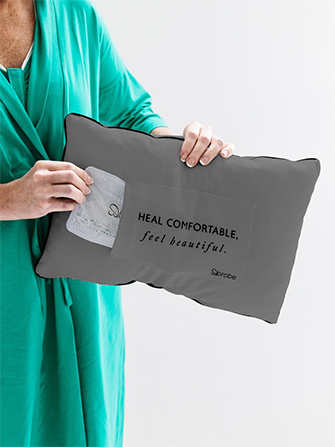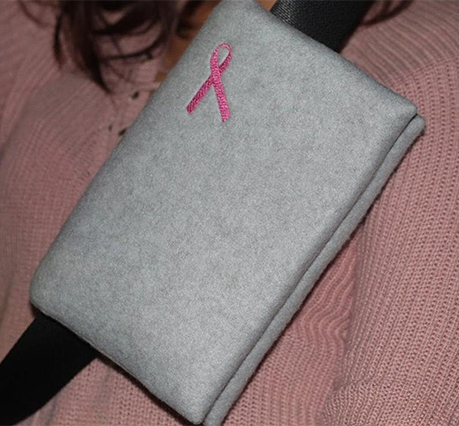Checklist for Recovery After Mastectomy
Jul 19th, 2024
Undergoing a mastectomy is a significant milestone in your journey to health, and recovery after a mastectomy can bring up many questions and emotions. Feeling relief, anxiety, and anticipation is normal as you begin this healing journey.
Understanding what to expect can empower you to care for yourself during recovery.
Think of this time as an opportunity to focus on your well-being and give your body the care it needs to heal. Whether you’re concerned about managing pain, caring for your surgical site, or handling daily activities, having a checklist can help you stay organized and informed.
With a few practical steps and some preparation, you’ll soon feel more comfortable and confident as you navigate your recovery.

Pre-Surgery Home Preparation
Preparing your home before returning from the hospital can make your recovery after a mastectomy much more comfortable and stress-free. With a few simple steps, you can create a relaxing environment that allows you to focus on healing and regain your strength.
Pre-Surgery Cleaning
Giving your home a thorough cleaning before surgery can make your recovery more comfortable. Focus on areas like the bedroom, bathroom, and den to ensure they are clutter-free and easy to navigate. Wash your bedding, arrange extra pillows for support, and ensure your bathroom has essentials like toiletries and clean towels.
Vacuum or sweep the floors and remove tripping hazards. These preparations will help create a peaceful and convenient environment that supports your healing process.
Comfortable Resting Area
Set up a cozy recovery space by arranging a comfortable chair or recliner with plenty of pillows for support. Keep a small table nearby for essentials like medications, water, snacks, and a phone charger. Ensure your favorite books, magazines, or TV remote are within easy reach for entertainment. Organize the area to minimize movement, and ensure your phone is nearby to call for assistance when needed.
Medical Supplies
Stock up on essential medical supplies like sterile gauze pads, adhesive bandages for dressing changes, and antiseptic wipes or solutions to clean the surgical area. A digital thermometer is vital for monitoring your temperature for signs of infection, while a pill organizer can help you manage medications. A measuring cup or syringe is handy for liquid doses.
Don’t forget extra surgical tape and scissors for quick bandage adjustments. These supplies will ensure you’re well-prepared for your recovery journey.
Meal Prep
Preparing meals before your surgery can make your recovery process much smoother. Plan to cook enough nutritious meals to last one to two weeks. This should be enough for you to attend your follow-up appointment with your surgeon and have your drains removed. It also allows time for your incisions to heal and any post-operative swelling to subside. Store your meals in single-serving containers in the freezer for easy reheating.
To support healing, focus on dishes packed with lean proteins, whole grains, fruits, and vegetables. Soups, stews, and casseroles are ideal because they reheat well and require minimal effort.
Also, keep healthy snacks like yogurt, nuts, and pre-cut fruits and vegetables readily available. These meals and snacks will save you energy and ensure you eat well during your recovery.
Immediate Post-Operative Care
Immediately following your mastectomy, a dedicated healthcare team will care for you to ensure your comfort and stability. This phase is centered on managing pain, monitoring your recovery, and preparing you for a smooth transition back home.
Hospital Stay
Following a mastectomy, your hospital stay usually ranges from one to three days, depending on the surgery type and your overall health. Medical staff will closely monitor your vital signs, such as blood pressure, heart rate, and temperature, to ensure your stability during this period.
Pain management will be a top priority, with your healthcare team providing medications to reduce discomfort. You’ll also receive instructions on caring for your surgical site and managing any drains before you head home.
Medications
After a mastectomy, you may be prescribed pain relievers such as acetaminophen (Tylenol), ibuprofen (Advil), or opioids like oxycodone or hydrocodone to manage discomfort. Your doctor may also prescribe antibiotics like cefazolin or clindamycin to prevent infection. Follow the dosage instructions carefully, taking medications at regular intervals.
Opioids can cause side effects like drowsiness, nausea, or constipation, while antibiotics may cause mild stomach upset or diarrhea. To minimize these effects, drink plenty of fluids and eat small, balanced meals. If side effects become severe, contact your healthcare provider.
Comfortable Apparel
When preparing for your mastectomy recovery, pack comfortable, loose-fitting clothes that are easy to put on and take off. Soft fabrics with front closures, like button-down shirts or zip-up tops, are ideal to avoid lifting your arms.

Compression garments, such as a post-surgical compression bra with drain management features, provide support and help reduce swelling. A camisole with a built-in bra allows you to step into it and pull it over your body, minimizing arm movement and ensuring comfort as you heal.
Other Hospital Essentials
When getting ready for your hospital stay after a mastectomy, it’s helpful to pack a few essential items for your comfort and convenience. Bring your ID and insurance card, but leave valuables and jewelry at home to avoid losing them. If you have an advance directive, you might also want to bring that along.
If you wear glasses, pack a case since you can’t wear them in the operating room, and skip bringing contact lenses. Don’t forget to pack some toiletries and lip balm to keep your skin and lips moisturized.
At-Home Wound Care and Hygiene
Taking care of your surgical site is a vital part of your recovery after a mastectomy. Following a few simple wound care and hygiene steps can help ensure a smooth healing process and reduce the risk of infection.
Incision Care
Cleaning and dressing your surgical site is essential for proper healing. Start by washing your hands thoroughly to prevent infection. Gently clean the area with mild soap and water, avoiding harsh scrubbing. Pat the site dry with a clean towel, then apply any prescribed ointment if directed by your doctor. Cover the wound with sterile gauze and secure it with medical tape, changing the dressing daily or as instructed.
Look For Signs of Infection
Check your surgical site daily for redness, swelling, or warmth around the area. Pay attention to any increase in pain or unusual discharge, like pus, and note any unpleasant odor. A fever over 100.4°F (38°C) can also be a warning sign. If you notice these symptoms, contact your healthcare provider immediately for guidance.
Drain Management
Properly managing your surgical drains is crucial for recovery. To empty and measure drainage, wash your hands first, then carefully open the drain plug. Pour the fluid into a measuring cup, noting the amount and color. Gently compress the drain bulb and re-secure the plug to maintain suction.
Record the volume in a log, tracking any changes over time. If you notice significant increases in drainage volume, unusual colors, or foul odors, contact your healthcare provider for further evaluation.
Showering and Bathing
Typically, you can start showering about 48 hours after your surgery, but always follow your surgeon’s specific instructions, as each case differs. When you’re ready, use a shower seat to sit and relax, minimizing the risk of feeling weak or unsteady. A detachable shower head lets you easily rinse off while seated, giving you greater independence.
Use a drain lanyard to secure any drains and tubing during your shower, and avoid hot water. Then, gently pat the incision site dry afterward.
Pain and Discomfort Management
Managing pain and discomfort after surgery is crucial to your recovery journey. By using a combination of medications and simple strategies, you can keep your pain under control and focus on healing comfortably.
Pain Relief Options
Pain relief after surgery can be managed with a combination of medications and alternative techniques. Your doctor may prescribe pain medications like acetaminophen or ibuprofen and sometimes opioids for more severe pain. Follow the dosage instructions carefully to avoid side effects.
For alternative pain management, try gentle breathing exercises or listening to calming music to help relax your body and mind. Gentle stretching and heat or cold therapy can also relieve and improve your comfort.
Keep a pack of throat lozenges handy for the first few days after surgery. The breathing tube used during the operation can dry out or irritate your mouth and throat.
Managing Swelling and Bruising
Managing swelling and bruising after surgery requires a few key strategies. To reduce swelling, apply ice packs to the surgical area for 15 to 20 minutes several times a day. Elevate your upper body with a wedge pillow while sleeping or resting on the sofa to reduce fluid buildup.

You can also use a mastectomy pillow with a cooling gel pack insert to support your chest and provide additional cooling relief. These measures can help ease discomfort and promote healing.
Addressing Emotional Well-being
Taking care of your emotional well-being is as important as your physical recovery. It’s normal to feel a mix of emotions after surgery, including anxiety or sadness. Talking to a counselor or joining a support group can provide comfort and understanding from others who have experienced similar challenges.
Practicing mindfulness or meditation can help manage stress and bring a sense of calm. Engaging in activities you enjoy, such as reading or crafting, can lift your spirits and provide a positive distraction.
Follow-Up Appointments
Follow-up appointments are an essential part of your recovery process. These visits allow your healthcare team to monitor your progress and adjust your care plan.
Scheduling and Attending Appointments
Scheduling and attending follow-up appointments is essential for tracking your recovery and catching potential issues early. Typically, your first follow-up visit will be about one to two weeks after surgery to check your incision, remove stitches or staples, and assess your overall healing. After that, you may have follow-ups every few weeks to monitor progress and address any complications, such as infection or lymphedema.
Discussing Concerns
It is important to address any issues or questions you might have with your healthcare provider during your follow-up appointments. Write down any symptoms you’re experiencing, such as unusual pain, swelling, or changes in the surgical area, so you don’t forget to mention them. If you’re feeling anxious or having difficulty with daily activities, let your doctor know.
Your healthcare provider can adjust your treatment plan based on this information, ensuring you receive the best care for your recovery. Having an open conversation will help you feel more in control and confident during your healing process.
Return to Physical Activity and Restrictions
Returning to your regular activities after surgery is an integral part of recovery, but it’s essential to take things slowly and follow your doctor’s guidelines. Knowing what activities are safe and which to avoid will help you heal properly and regain strength.
Movement and Exercise
In the first week after surgery, with your doctor’s approval, focus on gentle movements, such as shoulder shrugs and circles. Around two to three weeks post-surgery, you can incorporate light arm lifts and gentle stretches to help regain mobility.
If you’re healing well by four to six weeks, you may gradually increase your activity level with short walks and strengthening exercises. Always follow your healthcare provider’s specific recommendations and adjust based on how your body feels.
Lifting Restrictions
After surgery, you must be mindful of lifting restrictions to ensure a smooth recovery. In the first four weeks, avoid lifting anything heavier than 10 lbs., including grocery bags, laundry baskets, or small children.
For about six weeks, refrain from strenuous activities that could strain your chest muscles, like heavy lifting or pushing and pulling. As your healing progresses, your doctor will gradually clear you to lift more, so always follow their specific advice to prevent complications.
Driving
Driving after a mastectomy can be challenging due to limited arm movement and discomfort from seat belts. Most doctors recommend waiting at least two weeks before getting behind the wheel, but it can vary based on your healing process.

Before driving, you should feel comfortable turning the wheel and checking blind spots without pain. You can invest in a Breast & Chest Buddy Seat Belt Cushion for better comfort when driving or traveling in a car.
Support Systems
Whether it’s family, friends, or a support group, leaning on others for help and encouragement can boost your spirits and aid your healing process.
Family and Friends
Involving family and friends in your recovery process can make things much easier and more enjoyable. They can assist with household chores like childcare, cooking meals, doing laundry, and tidying up, allowing you to focus on resting. Loved ones can also help by running errands like grocery shopping or picking up prescriptions.
Having someone to drive you to follow-up appointments ensures you get the care you need without extra stress. Plus, spending time together offers emotional support and boosts your mood, making recovery a more positive experience.
Support Groups
Connecting with support groups can be helpful as you recover. They give you a chance to share your experiences with others who truly understand what you’re going through. Organizations like the NBCF Breast Cancer Support Group, After Breast Cancer Diagnosis (ABCD), and the Young Survival Coalition offer valuable resources and a sense of community.
These organizations provide both online forums and local meet-ups, making it easy to connect with others for advice, encouragement, and friendship as you navigate your recovery journey.
Moving Forward on Your Path to Recovery and Wellbeing
Recovering after a mastectomy can be a challenging journey, but you are not alone. With the proper support and resources, you can confidently navigate this period.
Whether you’re looking for comfortable clothing, helpful accessories, or specialized bras, Mastectomyshop.com has an extensive selection of products designed to support your recovery after a mastectomy. Explore our range today to find the perfect items to make your healing process smoother.



